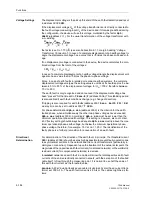
Functions
6-169
7SA6 Manual
C53000-G1176-C156-2
6.11.2 Applying the Function Parameter Settings
General
During the configuration of the device scope of functions (refer to Section 5.1, address
126
) it was determined which characteristics are to be available. Only those parame-
ters that apply to the available characteristics, according to the selected configuration
and the version of the device, are accessible in the procedures described below.
According to the desired operating mode of the overcurrent protection the address
2601
is set:
Operating Mode
=
ON
means that the overcurrent protection operates
independent on the other protection functions, in other words, as back-up overcurrent
protection. If the overcurrent protection should only operate as emergency protection
during loss of VT–supply, the setting
Only by VT loss
must be applied. Finally, the
overcurrent protection can also be switched
OFF
.
If not all the stages are required, the time delay of those stages that are not used can
be deactivated by setting the pickup value to
∞
. But if you set an associated time delay
to
∞
this does not suppress the pick-up annunciations, but merely prevents the time
delay from expiring.
The stub protection remains in service even if the overcurrent mode of operation set-
ting is
Only by VT loss
.
One or more stages can be set as fast tripping stages when switching on to a dead
fault. This will be determined when setting the individual stages (see below). To avoid
a spurious pick-up due to transient overcurrents, the delay
T SOTF
(address
2680
)
can be set. Typically the presetting of 0 is correct. On long cables, where large inrush
currents may arise, or on transformers, a short time delay setting may be reasonable.
The time delay depends on the severity and duration of the transient overcurrents as
well as on which stages were selected for the fast switch onto fault clearance.
High Set
Overcurrent Stages
Iph>>, 3I0>>
The I>>–stages
Iph>>
(address
2610
) and
3I0>>
(address
2612
) along with the
I>–stages or the I
p
–stages result in a dual stage characteristic. Of course, it is also
possible to combine all three stages. If a particular stage is not required, its pickup val-
ue is set to
∞
. The I>>–stages always operate with a defined time delay.
If the I>>–stages are used as a fast tripping stage prior to automatic reclosure, the cur-
rent setting corresponds to that of the I>– or I
p
–stages (see below). In this case only
the difference in the trip delay times is of interest. The times
T Iph>>
(address
2611
)
and
T 3I0>>
(address
2613
) can be set to
0
or a very small value as rapid clearance
of the fault current prior to an automatic reclosure has preference above the selective
fault clearance. Prior to the final trip, these stages must be blocked to achieve selec-
tive final clearance of the fault.
On very long lines with a small source impedance or in front of large reactances (e.g.
transformers, series reactors), the I>>–stages can also be used for current grading. In
this case they must be set such that they definitely do not pick up for a fault at the end
of the line. The time delays can then be set to
0
or a very small value.
When using a personal computer and DIGSI
®
4 to apply the settings, these can be op-
tionally entered as primary or secondary values. When applying the setting parame-
ters as secondary values, the primary currents must be converted to the secondary
side of the current transformer.
Summary of Contents for siprotec 7SA6
Page 2: ...Siemens Aktiengesellschaft Book No C53000 G1176 C156 2 ...
Page 18: ...xviii 7SA6 Manual C53000 G1176 C156 2 ...
Page 32: ...Introduction 1 14 7SA6 Manual C53000 G1176 C156 2 ...
Page 82: ...Hardware and Connections 2 50 7SA6 Manual C53000 G1176 C156 2 ...
Page 119: ...SIPROTEC 4 Devices 4 25 7SA6 Manual C53000 G1176 C156 2 Figure 4 20 CFC Logic example ...
Page 190: ...Configuration 5 62 7SA6 Manual C53000 G1176 C156 2 ...
Page 652: ...Installation and Commissioning 8 78 7SA6 Manual C53000 G1176 C156 2 ...
Page 724: ...Technical Data 10 56 7SA6 Manual C53000 G1176 C156 ...
Page 800: ...Appendix A 76 7SA6 Manual C53000 G1176 C156 2 ...
Page 866: ...Appendix B 66 7SA6 Manual C53000 G1176 C156 2 ...
















































